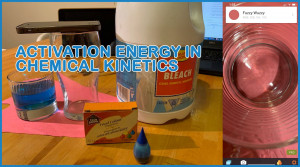Overview
In this CLAW (Chemistry Laboratory Alternative Work) At-Home experiment, students will perform an experiment using household chemicals and materials. It was designed as a substitute for in-person laboratories, usually performed at the college level, during the COVID-19 pandemic. However, it may also be used as an experiment that students can carry out in the lab or for student projects.
Instructional Objectives
The objective of this at-home experiment is to demonstrate how the rate of a chemical reaction is temperature-dependent. The reaction of blue food dye with sodium hypochlorite as represented by the following reaction equation: Blue dye (aq) + NaOCl (aq) → Colourless Products (aq) will be carried out at various temperatures in order to evaluate its activation energy.

Contributor's Notes
Carmen Leung
Dawson College, Montreal
Benefits
- This hands-on home experiment is an engaging way to manipulate and measure chemical compounds outside an official laboratory set-up;
- Experimental data recorded by the students can be analyzed to perform calculations and write a complete lab report.
Challenges
- It may be difficult to estimate the time needed for students to complete this activity at home.
- Gathering of chemicals and material usually carried out by a technician must be done by each student.
Tips
- The list of chemicals and material necessary for the experiment should be given to students as soon as possible to make sure they have the time to purchase and gather the needed items;
- Equipment could be loaned out to the students from the college;
- It’s important the students use bleach that is not more than 6 months old, and that the concentration of NaOCl is indicated on the bottle (generic / no name brands typically do not indicate the concentration). Bleach older than 6 months will have a reduced concentration of NaOCl and can slow the reaction rate down considerably;
- When carrying out the reaction, make sure there are no shadows casted on the reaction glass, the reaction glass is not sitting in direct sunlight, and that the room is not dark;
- When centering the reaction glass in the cell phone camera, adjust the color identifier so that it reads an area of red that is bright (higher R value);
- Do not move the cellphone once it’s in place, test out your hand movements before starting the experiment (tap the screen to go back and forth between the live view and the RGB readings);
- Ensure all the equipment is dry before starting a new run;
- Ensure the reaction glass stays dry on the outside to prevent getting the red construction paper wet, otherwise, it may darken the spot where the absorbance is being measured;
- For the colder and warmer temperature runs, measure the temperature of the water in the measuring cup before adding the bleach to see if the temperature is in the desired range;
- Once the bleach is added, the temperature will change approximately 1 degree Celsius, but it should be measured accurately and recorded on the data sheet;
- If a student does not have access to a smartphone, then the student can be paired up with another student who has a smartphone and they can work together virtually (one student carries out the experiment, while the other watches and records the data).
Additional Contributors
Published: 16/07/2020
Copyright: © 2024 Brouillette, Leung and Schoonhoven. This is an open-access article distributed under the terms of the Creative Commons Attribution License (CC BY). The use, distribution or reproduction in other forums is permitted, provided the original author(s) and the copyright owner(s) are credited and that the original publication on this website is cited, in accordance with accepted academic practice. No use, distribution or reproduction is permitted which does not comply with these terms.





